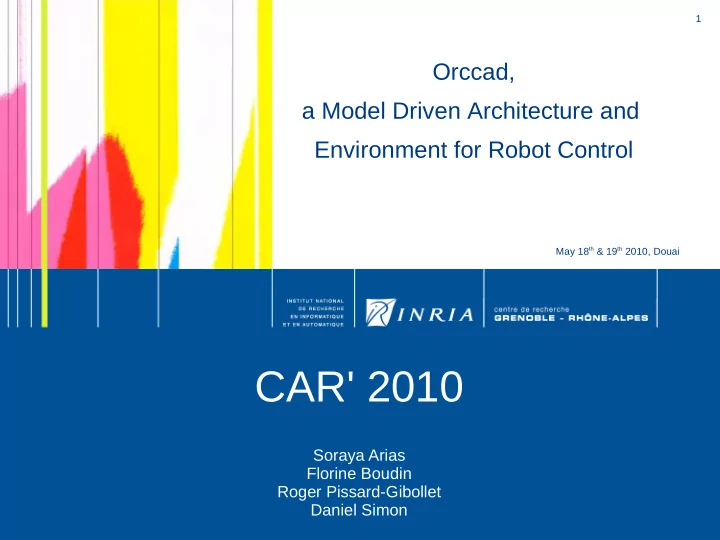

1 Orccad, a Model Driven Architecture and Environment for Robot Control May 18 th & 19 th 2010, Douai CAR' 2010 Soraya Arias Florine Boudin Roger Pissard-Gibollet Daniel Simon
2 Orccad : status and motivations Model: • Control design oriented approach for robotics • Mixed feedback and discrete events Tools: • Design & simulation/validation • Real-time workshop V4 modeling and software development: • Aging version, based on proprietary tools • Sound model & design approach • Model Driven Architecture based on Eclipse Modeling Tools • Open Source software
3 The Orccad model Top-down requirements capture Bottom-up design RobotTasks ● Feedback Control ● Cyclic real-time data flow ● Event-based view RobotProcedures ● Discrete Events Control ● Incremental design ● Exception processing ● Mission definition
4 Quadrotor networked control & diagnosis Networked system ● CAN bus ● Distributed diagnosis ● Fault tolerant control Flexible scheduling ● Varying sampling ● (m,k)-firm ● Dynamic priorities Hardware-in-the-loop ● Linux simulation ● PPC embedded V4 Runtime update (SafeNecs ANR)
5 Drone control block-diagram Networked system ● CAN bus ● Distributed diagnosis ● Fault tolerant control Flexible scheduling ● Varying sampling ● (m,k)-firm ● Dynamic priorities Hardware-in-the-loop ● Linux simulation ● PPC embedded V4 Runtime update
6 Orccad components: RobotTask Feedback control action ● Control algorithm definition ● Modular design ● Functional parameters ● Timing parameters Event based behaviour ● Precondition ● Synchronization ● Exception ● Weak T1 ● Strong T2 ● Fatal T3 ● Postcondition
7 Orccad components: Modules Implement functions Algorithmic Phy_Resource (drivers) Typed Input/Output ports ● Data ● Drivers ● Parameters ● Events User defined C code init (inputs) forever{ compute (inputs) } end ()
8 Orccad components: Temporal Constraint Real time threads ● Task ID ● Modules ID ● Priority ● Synchronization ● Clock ● Output port ● Extern event ● Overrun policy ● Skip, Soft, Hard ● User's defined ● WCET ● CPU ID
9 Orccad components: RobotProcedure ● Composition of control actions ● Incremental design ● From exception processing to mission definition ● Currently written in Esterel See next talk!
10 Runtime Code generation ● C++ classes ● Virtual system calls Compilation ● Binding to real calls ● Link with specific runtime library ● Linux/Posix ● Xenomai/Native ● ...
11 MDA in Orccad • Eclipse Modeling Project based on the idea of a Model (MetaModel) • EMP offers different tools for different goals : EMF, GMF, Xpand... • Principe of plug-in in the Eclipse Environment XSD Java UML Ecore
12 Orccad by Developer & User As a Developer Orccad Software MetaModel
13 Orccad by Developer & User As a User Orccad metamodel
14 MDA : How it works The Metamodel defines how a model is made. MetaModel Made by the developer. The Model is realized by the user. Model It matches to the meta-model and its constraints. It generates the source code from the model, using templates defined by the developer . Generator
15 MetaModel - an example The graphical view is close to an UML model.
16 MetaModel - an example Code is generated in Java, we find Java properties in the Ecore model. Class
17 MetaModel - an example Code generated in Java, we find Java properties in the Ecore model. Inheritance
18 MetaModel - an example References
19 EMF – Tree Editor ● A plugin developed in the Eclipse project ● From a metamodel, generates a Tree Editor as a plugin ● For Eclipse ● RCP plugin ● Really useful to realize beta-version ● Constraints must be defined and filled at this step.
20 EMF – Tree Editor ● Generation of Code ● Creation of a new Project (Plug-in) ● Packages by functions ● All the customization on eclipse plug-in are allowed ● Generated code must be modified and/or completed. With keyword, a re-generation of the code is safe.
21 EMF – Tree Editor
22 GMF – Graphical Editor ● The Tree Editor must be generated before the generation of the Graphical Editor. ● We specify through files ● Graphical representations of elements and links ● Palette tool ● Mapping, the coherence between view, ecore and palette. ● Then we can generate the Graphical Editor.
23 GMF – Graphical Editor Graphical Interface Code : - MVC design pattern Model, Controller and View are independent for a easier maintenance.
24 GMF – Graphical Editor Result of a quick Graphical Interface uncluttered -> customization !
25 GMF – Graphical Editor Example of a simple customization
26 Xpand – The Code generator Why Xpand ? ➢ Xpand is proposed as a M2T (Model to Text ) technology in the Eclipse Modeling Project ➢ It fits with the Ecore Metamodel ➢ Entirely customization for any type of file ➢ Templates have a simple syntax ➢ Code generator is independent from the source code
27 Xpand – The Code generator Meta Model .ecore ● Source code XPAND ● Documentation files ● Webpages Model ● Whatever you want Templates .xpt
28 Eclipse tooling assessment • Disadvantages ● Advantages ✗ Abandoned tools ✔ Eclipse Environment ✗ Choices ✔ Model and Code independence ✗ Technology not easy to master ✔ Extensibility/scalability ✔ Fast when technology mastered
29 http://orccad.gforge.inria.fr Opening soon! Questions ?
Recommend
More recommend